Abstract
The red cells of patients with hereditary erythroblastic multinuclearity with a positive acidified serum test (HEMPAS), a form of congenital dyserythropoietic anemia, and the cells of patients with paroxysmal nocturnal hemoglobinuria (PNH) are lysed more readily than normal cells by certain antibodies, notably cold agglutinins (anti-I) and complement. With some but not other examples of anti-I, HEMPAS and PNH cells adsorbed more antibody than normal cells. Equal quantities of adsorbed antibody bound equal quantities of the first component of complement (C1) to normal, PNH, and HEMPAS cells. However, for a given quantity of bound antibody and C1, much more of the fourth component of complement (C4) was bound to HEMPAS cells than to normal cells. This resulted in the binding of proportionately larger quantities of the third component of complement (C3) to these cells. The same amount of bound C3 was found on the membranes of normal and HEMPAS cells for a given degree of lysis. Hence, the marked increase in lysis of HEMPAS cells is due to the increased adsorption of antibody and/or increased binding of C4.
PNH cells bound the same amount of C4 per bound C1 as normal cells but bound more C3 than normal cells. However, the mean concentration of C3 on the membrane of PNH cells was one-third to one-fifth that on normal cells for a given degree of lysis. Hence, the increased lysis of PNH cells is due to the increased binding of C3 and increased hemolytic effectiveness of the bound C3.
Full text
PDF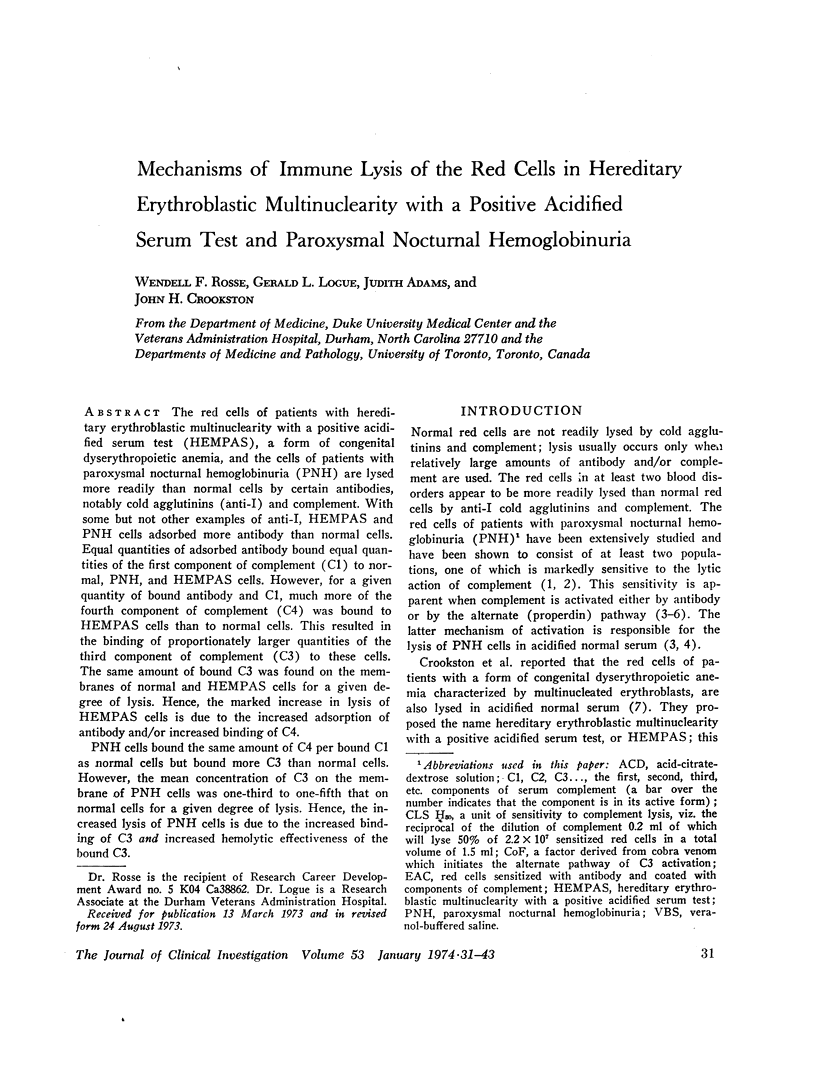
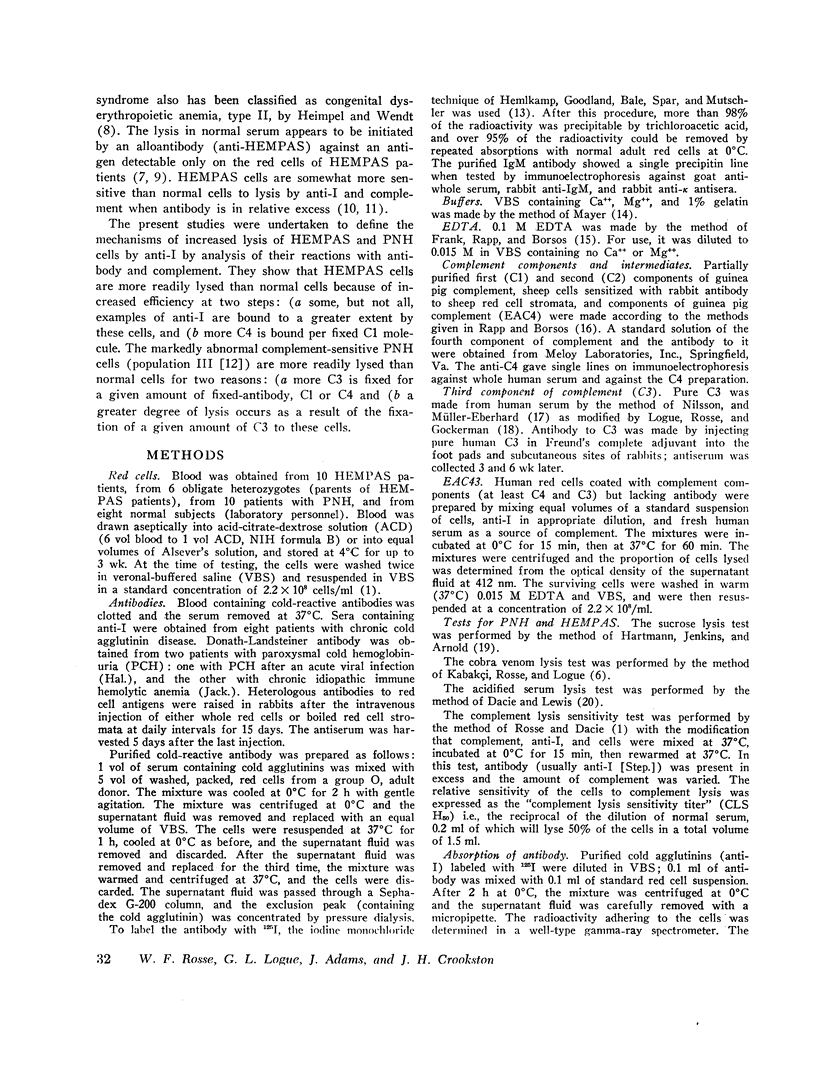
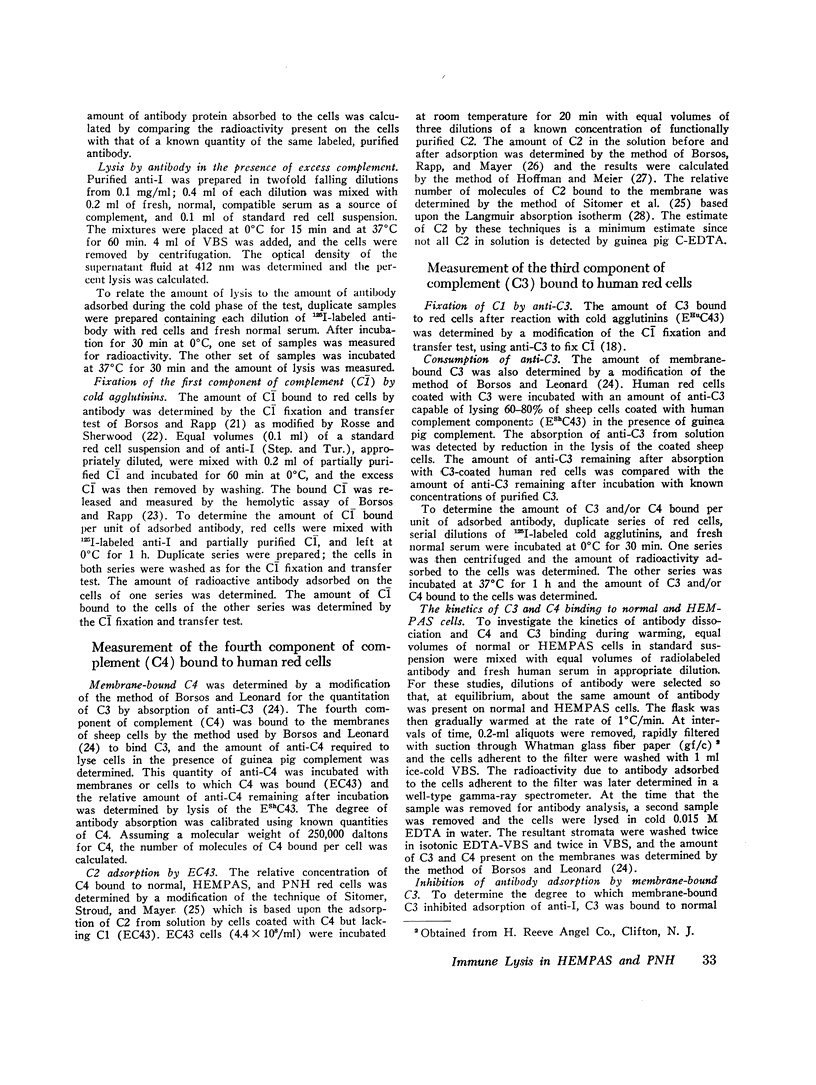
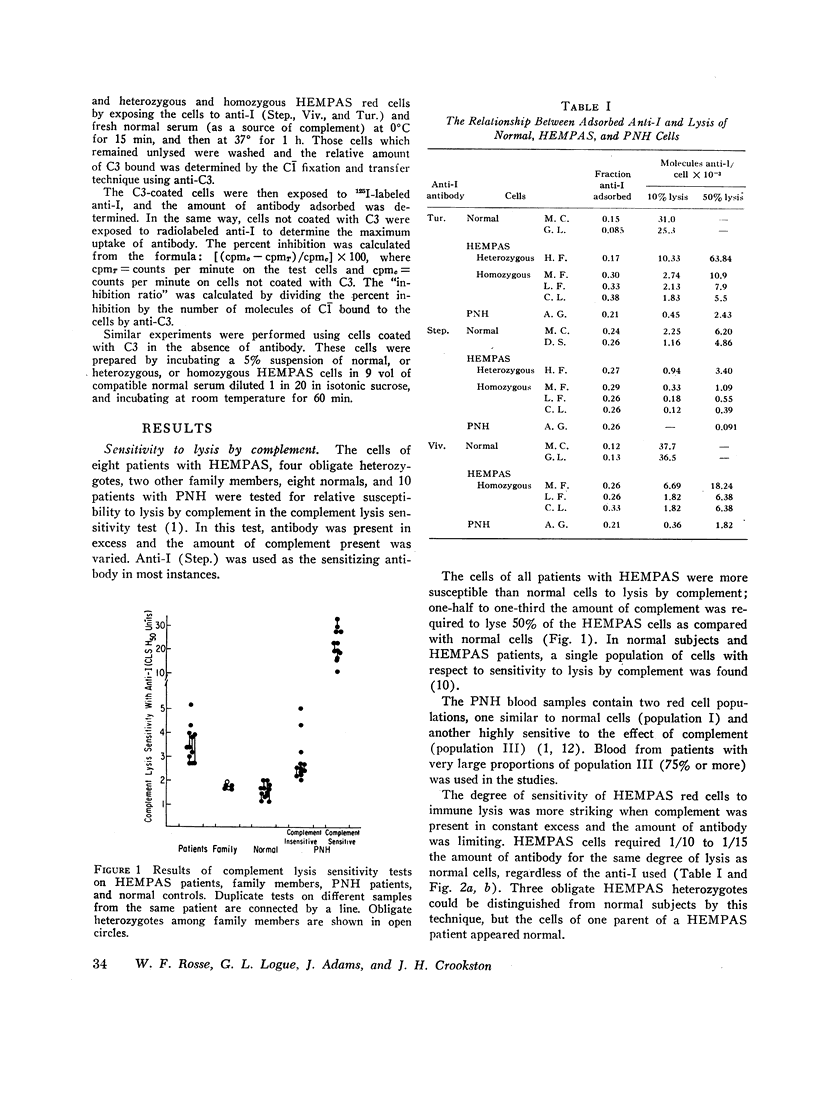
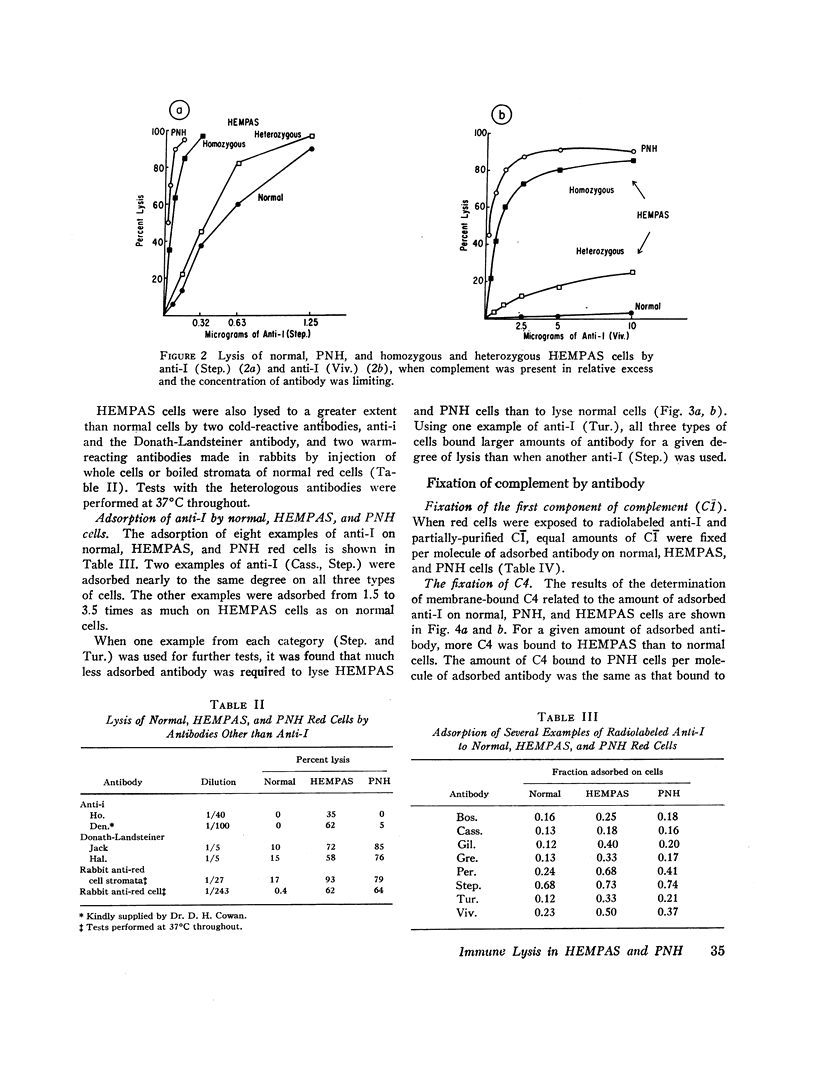
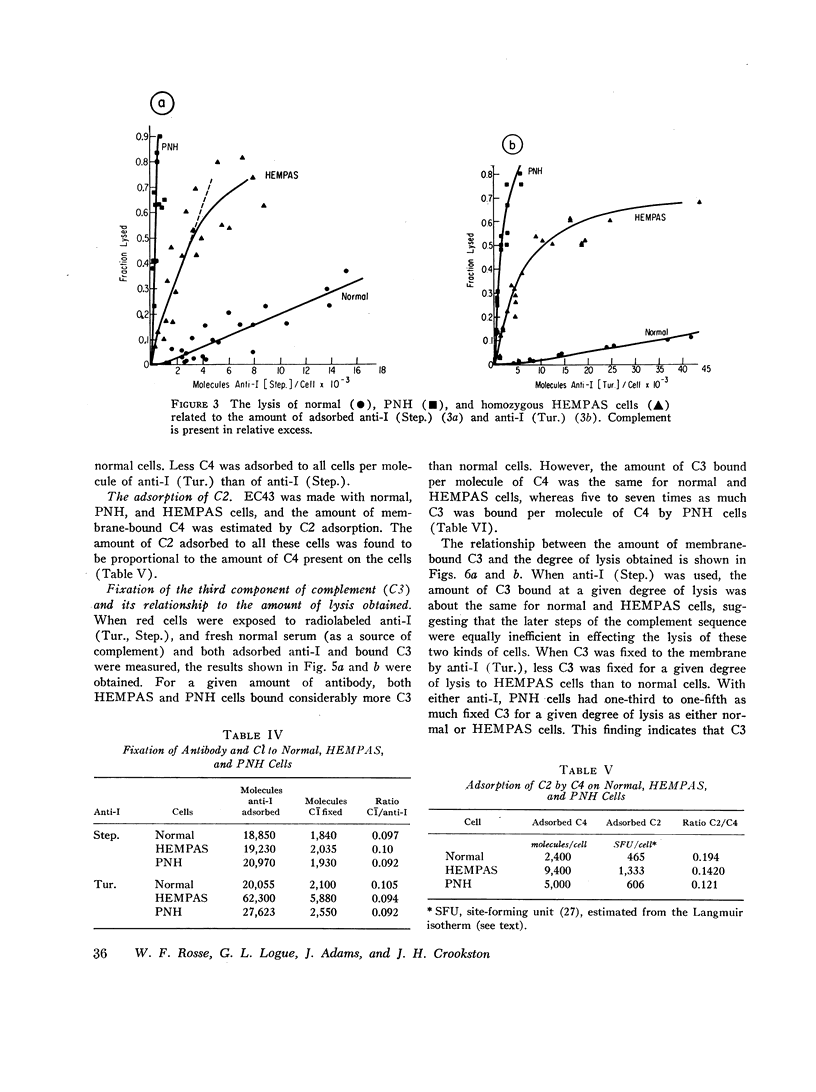
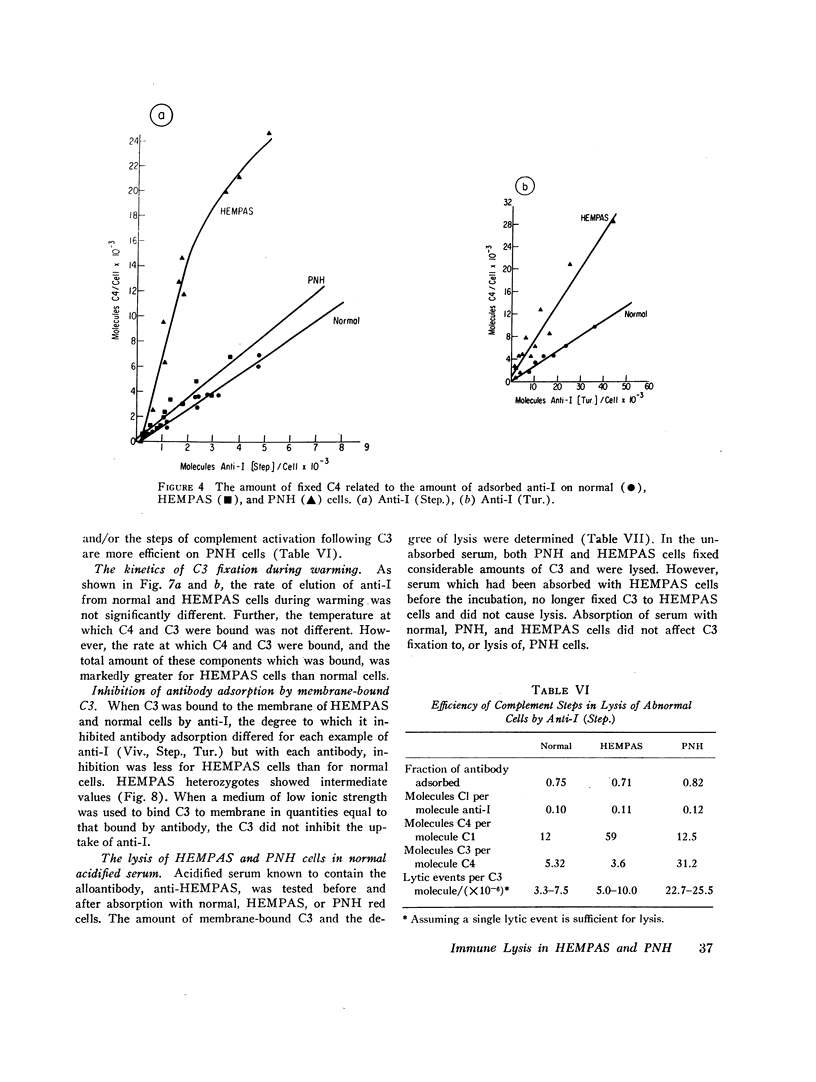
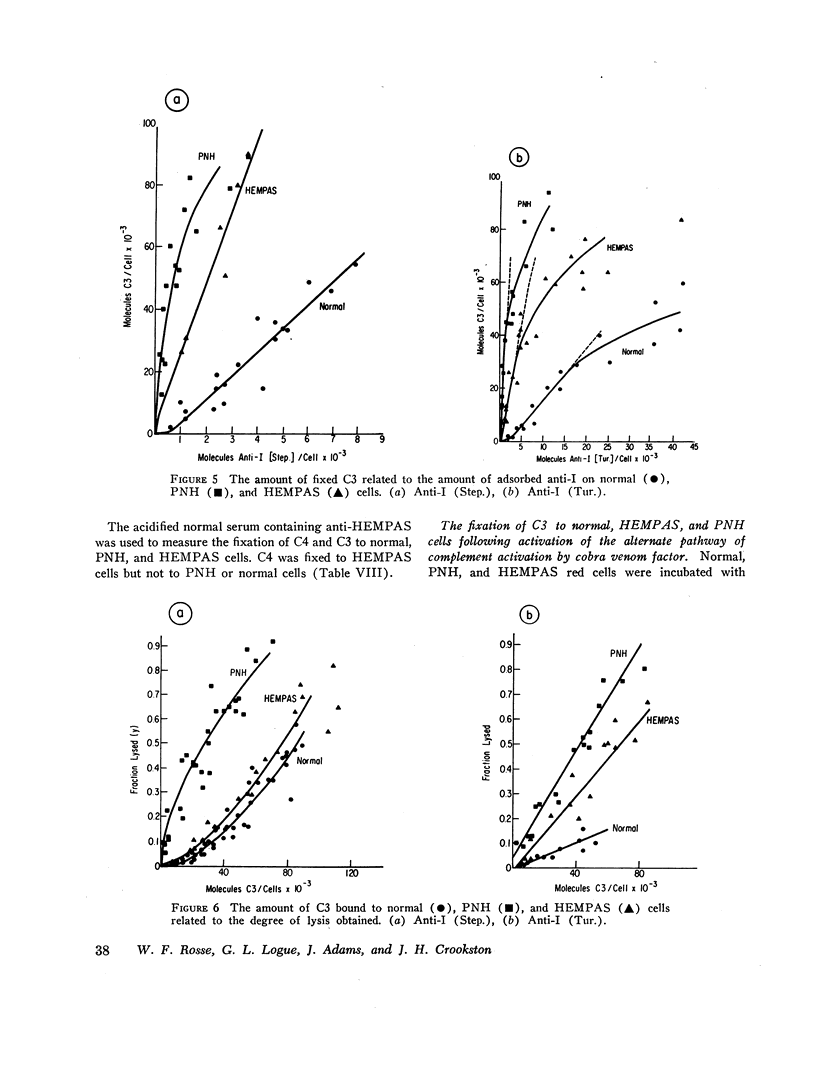
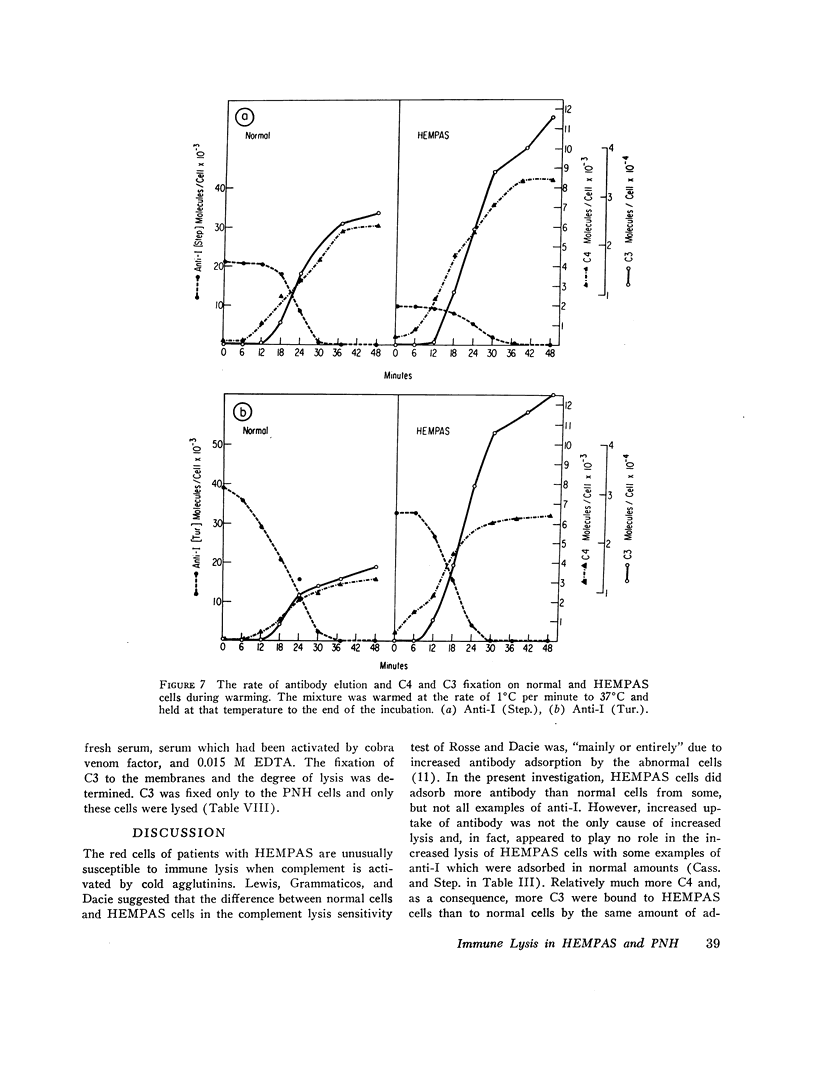
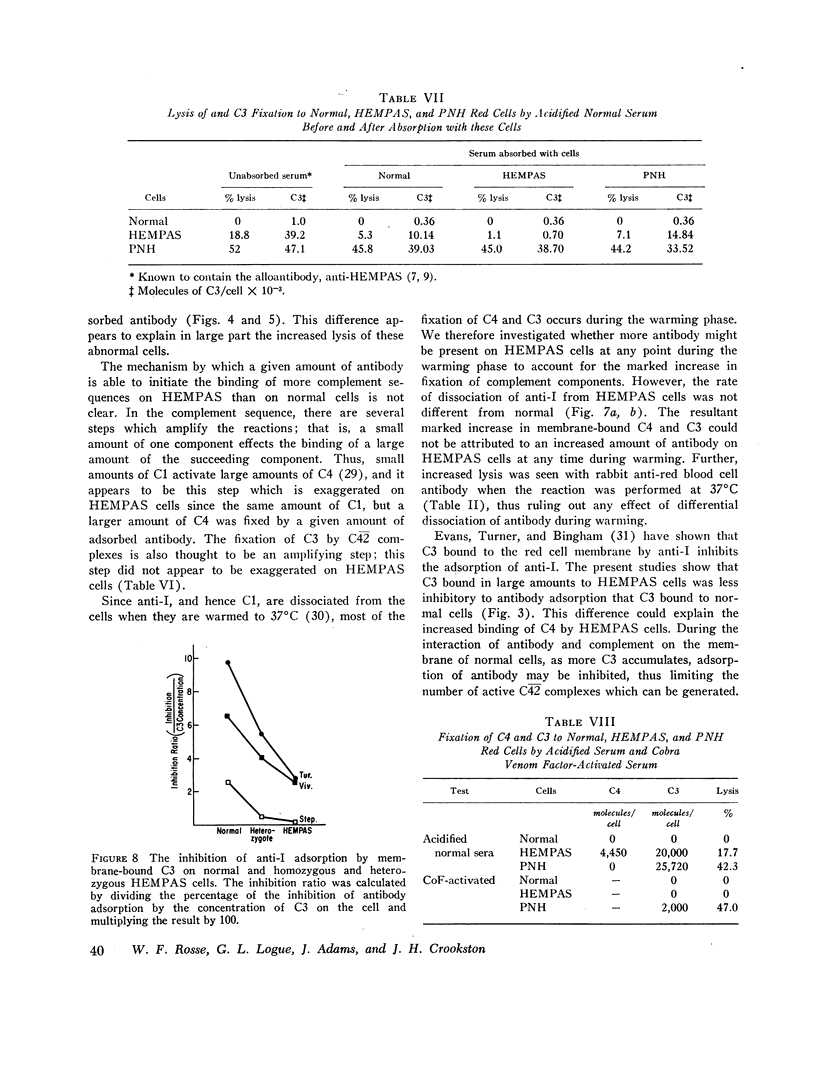
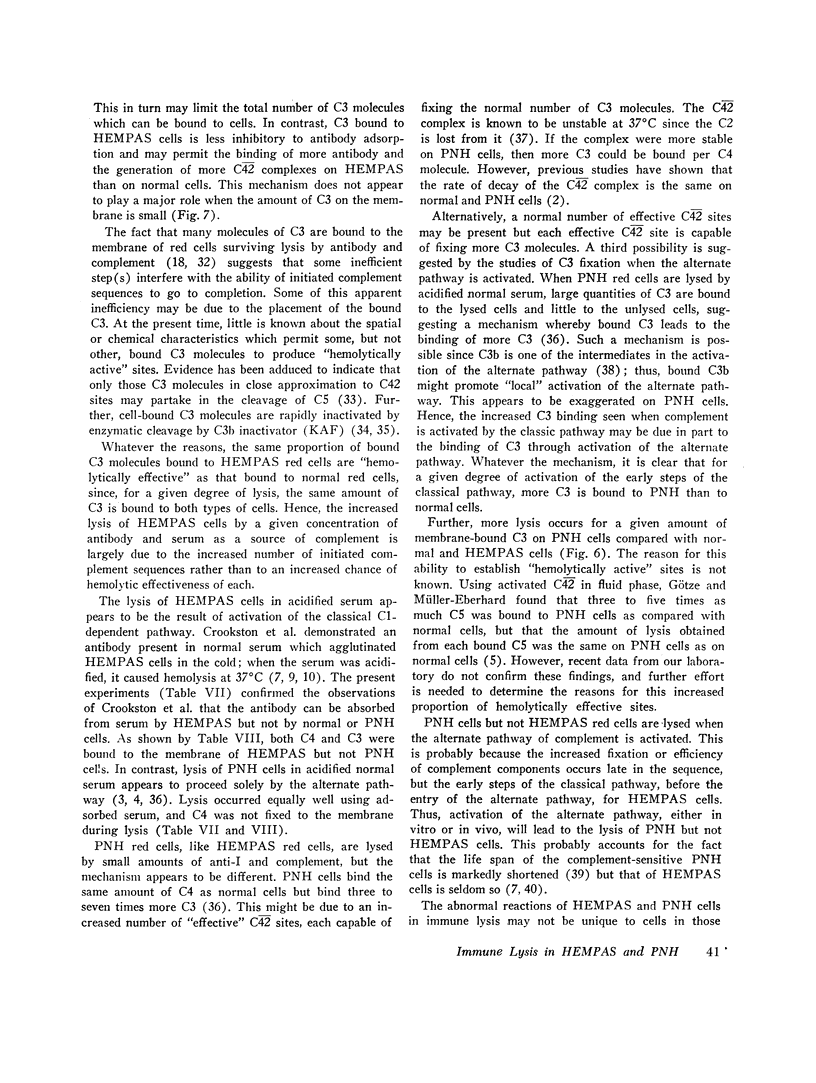
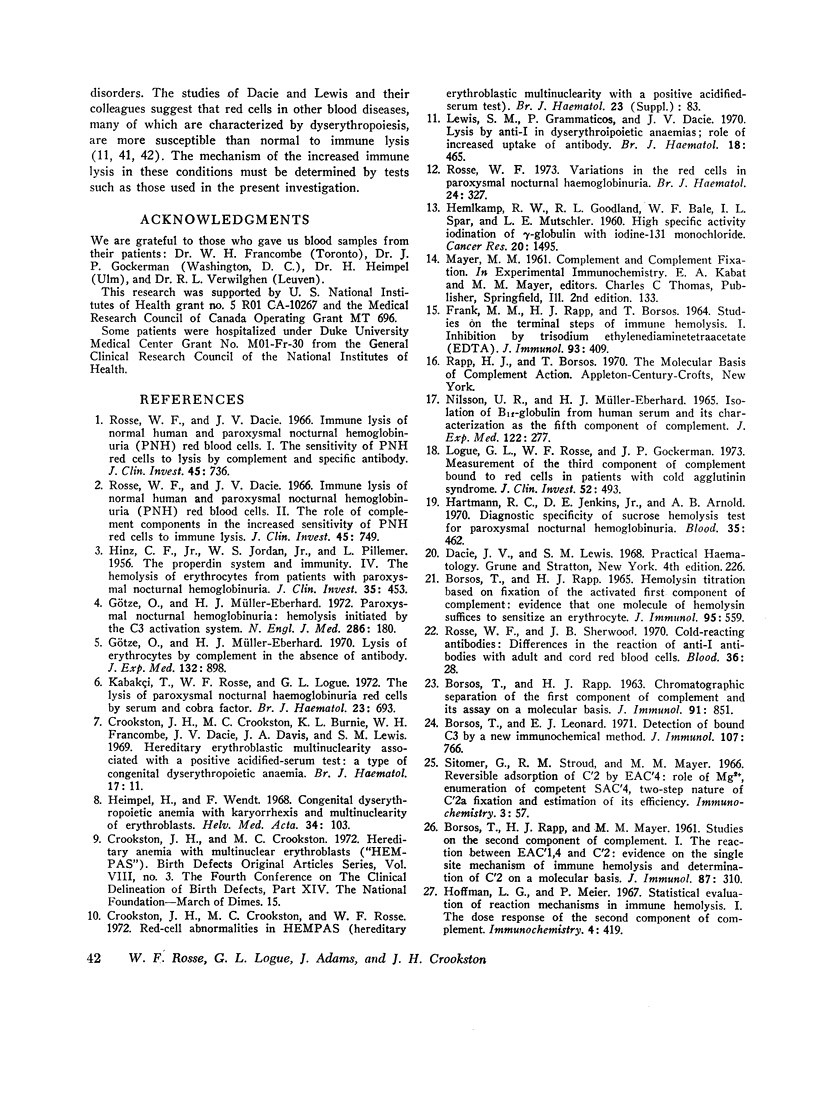
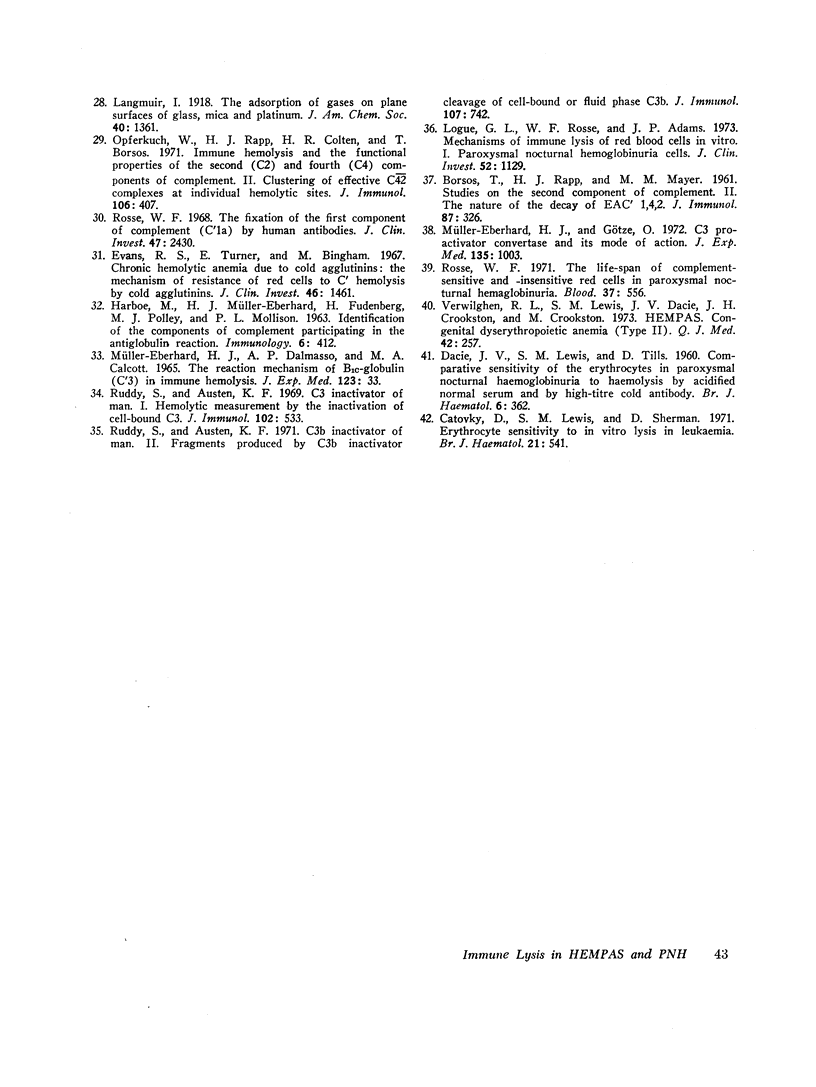
Selected References
These references are in PubMed. This may not be the complete list of references from this article.
- BORSOS T., RAPP H. J. CHROMATOGRAPHIC SEPARATION OF THE FIRST COMPONENT OF COMPLEMENT AND ITS ASSAY ON A MOLECULAR BASIS. J Immunol. 1963 Dec;91:851–858. [PubMed] [Google Scholar]
- Borsos T., Leonard E. J. Detection of bound C3 by a new immunochemical methods. J Immunol. 1971 Sep;107(3):766–771. [PubMed] [Google Scholar]
- Borsos T., Rapp H. J. Hemolysin titration based on fixation of the activated first component of complement: evidence that one molecule of hemolysin suffices to sensitize an erythrocyte. J Immunol. 1965 Sep;95(3):559–566. [PubMed] [Google Scholar]
- Catovsky D., Lewis S. M., Sherman D. Erythrocyte sensitivity to in-vitro lysis in leukaemia. Br J Haematol. 1971 Nov;21(5):541–550. doi: 10.1111/j.1365-2141.1971.tb02715.x. [DOI] [PubMed] [Google Scholar]
- Crookston J. H., Crookston M. C., Burnie K. L., Francombe W. H., Dacie J. V., Davis J. A., Lewis S. M. Hereditary erythroblastic multinuclearity associated with a positive acidified-serum test: a type of congenital dyserythropoietic anaemia. Br J Haematol. 1969 Jul;17(1):11–26. doi: 10.1111/j.1365-2141.1969.tb05660.x. [DOI] [PubMed] [Google Scholar]
- Crookston J. H., Crookston M. C., Rosse W. F. Red-cell abnormalities in HEMPAS (hereditary erythroblastic multinuclearity with a positive acidified-serum test). Br J Haematol. 1972 Sep;23(Suppl):83–91. doi: 10.1111/j.1365-2141.1972.tb03507.x. [DOI] [PubMed] [Google Scholar]
- DACIE J. V., LEWIS S. M., TILLS D. Comparative sensitivity of the erythrocytes in paroxysmal nocturnal haemoglobinuria to haemolysis by acidified normal serum and by high-titre cold antibody. Br J Haematol. 1960 Oct;6:362–371. doi: 10.1111/j.1365-2141.1960.tb06254.x. [DOI] [PubMed] [Google Scholar]
- Evans R. S., Turner E., Bingham M. Chronic hemolytic anemia due to cold agglutinins: the mechanism of resistance of red cells to C' hemolysis by cold agglutinins. J Clin Invest. 1967 Sep;46(9):1461–1474. doi: 10.1172/JCI105638. [DOI] [PMC free article] [PubMed] [Google Scholar]
- FRANK M. M., RAPP H. J., BORSOS T. STUDIES ON THE TERMINAL STEPS OF IMMUNE HEMOLYSIS. I. INHIBITION BY TRISODIUM ETHYLENEDIAMINETETRAACETATE (EDTA). J Immunol. 1964 Sep;93:409–413. [PubMed] [Google Scholar]
- Götze O., Müller-Eberhard H. J. Lysis of erythrocytes by complement in the absence of antibody. J Exp Med. 1970 Nov;132(5):898–915. doi: 10.1084/jem.132.5.898. [DOI] [PMC free article] [PubMed] [Google Scholar]
- Götze O., Müller-Eberhard H. J. Paroxysmal nocturnal hemoglobinuria. Hemolysis initiated by the C3 activator system. N Engl J Med. 1972 Jan 27;286(4):180–184. doi: 10.1056/NEJM197201272860403. [DOI] [PubMed] [Google Scholar]
- HARBOE M., MUELLER-EBERHARD H. J., FUDENBERG H., POLLY M. J., MOLLISON P. L. IDENTIFICATION OF THE COMPONENTS OF COMPLEMENT PARTICIPATING IN THE ANTIGLOBULIN REACTION. Immunology. 1963 Jul;6:412–420. [PMC free article] [PubMed] [Google Scholar]
- HELMKAMP R. W., GOODLAND R. L., BALE W. F., SPAR I. L., MUTSCHLER L. E. High specific activity iodination of gamma-globulin with iodine-131 monochloride. Cancer Res. 1960 Nov;20:1495–1500. [PubMed] [Google Scholar]
- HINZ C. F., Jr, JORDAN W. S., Jr, PILLEMER L. The properdin system and immunity. IV. The hemolysis of erythrocytes from patients with paroxysmal nocturnal hemoglobinuria. J Clin Invest. 1956 May;35(5):453–457. doi: 10.1172/JCI103296. [DOI] [PMC free article] [PubMed] [Google Scholar]
- Hartmann R. C., Jenkins D. E., Jr, Arnold A. B. Diagnostic specificity of sucrose hemolysis test for paroxysmal nocturnal hemoglobinuria. Blood. 1970 Apr;35(4):462–475. [PubMed] [Google Scholar]
- Heimpel H., Wendt F. Congenital dyserythropoietic anemia with karyorrhexis and multinuclearity of erythroblasts. Helv Med Acta. 1968 Mar;34(2):103–115. [PubMed] [Google Scholar]
- Kabakçi T., Rosse W. F., Logue G. L. The lysis of paroxysmal nocturnal haemoglobinuria red cells by serum and cobra factor. Br J Haematol. 1972 Dec;23(6):693–705. doi: 10.1111/j.1365-2141.1972.tb03484.x. [DOI] [PubMed] [Google Scholar]
- Lewis S. M., Grammaticos P., Dacie J. V. Lysis by anti-I in dyserythropoietic anaemias: role of increased uptake of antibody. Br J Haematol. 1970 Apr;18(4):465–474. doi: 10.1111/j.1365-2141.1970.tb01459.x. [DOI] [PubMed] [Google Scholar]
- Logue G. L., Rosse W. F., Adams J. P. Mechanisms of immune lysis of red blood cells in vitro. I. Paroxysmal nocturnal hemoglobinuria cells. J Clin Invest. 1973 May;52(5):1129–1137. doi: 10.1172/JCI107279. [DOI] [PMC free article] [PubMed] [Google Scholar]
- Logue G. L., Rosse W. F., Gockerman J. P. Measurement of the third component of complement bound to red blood cells in patients with the cold agglutinin syndrome. J Clin Invest. 1973 Feb;52(2):493–501. doi: 10.1172/JCI107206. [DOI] [PMC free article] [PubMed] [Google Scholar]
- Müller-Eberhard H. J., Götze O. C3 proactivator convertase and its mode of action. J Exp Med. 1972 Apr 1;135(4):1003–1008. doi: 10.1084/jem.135.4.1003. [DOI] [PMC free article] [PubMed] [Google Scholar]
- Müllerèberhard H. J., Dalmasso A. P., Calcott M. A. The reaction mechanism of beta-1C-globulin (C'3) in immune hemolysis. J Exp Med. 1966 Jan 1;123(1):33–54. doi: 10.1084/jem.123.1.33. [DOI] [PMC free article] [PubMed] [Google Scholar]
- NILSSON U. R., MUELLER-EBERHARD H. J. ISOLATION OF BETA IF-GLOBULIN FROM HUMAN SERUM AND ITS CHARACTERIZATION AS THE FIFTH COMPONENT OF COMPLEMENT. J Exp Med. 1965 Aug 1;122:277–298. doi: 10.1084/jem.122.2.277. [DOI] [PMC free article] [PubMed] [Google Scholar]
- Opferkuch W., Rapp H. J., Colten H. R., Borsos T. Immune hemolysis and the functional properties of the second (C2) and fourth (C4) components of complement. II. Clustering of effective C42 complexes at individual hemolytic sites. J Immunol. 1971 Feb;106(2):407–413. [PubMed] [Google Scholar]
- Rosse W. F., Dacie J. V. Immune lysis of normal human and paroxysmal nocturnal hemoglobinuria (PNH) red blood cells. I. The sensitivity of PNH red cells to lysis by complement and specific antibody. J Clin Invest. 1966 May;45(5):736–748. doi: 10.1172/JCI105388. [DOI] [PMC free article] [PubMed] [Google Scholar]
- Rosse W. F., Dacie J. V. Immune lysis of normal human and paroxysmal nocturnal hemoglobinuria (PNH) red blood cells. II. The role of complement components in the increased sensitivity of PNH red cells to immune lysis. J Clin Invest. 1966 May;45(5):749–757. doi: 10.1172/JCI105389. [DOI] [PMC free article] [PubMed] [Google Scholar]
- Rosse W. F. Fixation of the first component of complement (C'la) by human antibodies. J Clin Invest. 1969 Nov;47(11):2430–2445. doi: 10.1172/JCI105926. [DOI] [PMC free article] [PubMed] [Google Scholar]
- Rosse W. F., Sherwood J. B. Cold-reacting antibodies: differences in the reaction of anti-I antibodies with adult and cord red blood cells. Blood. 1970 Jul;36(1):28–42. [PubMed] [Google Scholar]
- Rosse W. F. The life-span of complement-sensitive and -insensitive red cells in paroxysmal nocturnal hemoglobinuria. Blood. 1971 May;37(5):556–562. [PubMed] [Google Scholar]
- Rosse W. F. Variations in the red cells in paroxysmal nocturnal haemoglobinuria. Br J Haematol. 1973 Mar;24(3):327–342. doi: 10.1111/j.1365-2141.1973.tb01657.x. [DOI] [PubMed] [Google Scholar]
- Ruddy S., Austen K. F. C3 inactivator of man. I. Hemolytic measurement by the inactivation of cell-bound C3. J Immunol. 1969 Mar;102(3):533–543. [PubMed] [Google Scholar]
- Ruddy S., Austen K. F. C3b inactivator of man. II. Fragments produced by C3b inactivator cleavage of cell-bound or fluid phase C3b. J Immunol. 1971 Sep;107(3):742–750. [PubMed] [Google Scholar]
- Sitomer G., Stroud R. M., Mayer M. M. Reversible adsorption of C'2 by EAC'4: role of Mg2+, enumeration of competent SAC'4, two-step nature of C'2a fixation and estimation of its efficiency. Immunochemistry. 1966 Jan;3(1):57–69. doi: 10.1016/0019-2791(66)90282-5. [DOI] [PubMed] [Google Scholar]
- Verwilghen R. L., Lewis S. M., Dacie J. V., Crookston J. H., Crookston M. C. Hempas: congenital dyserythropoietic anaemia (type II). Q J Med. 1973 Apr;42(166):257–278. [PubMed] [Google Scholar]


